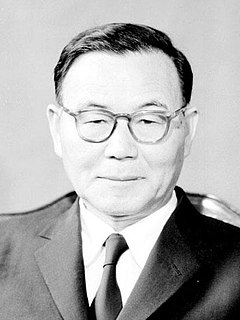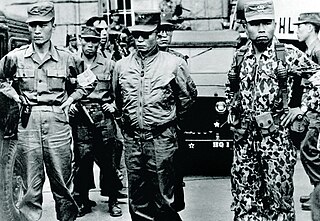
The history of South Korea formally begins with the Japanese surrender on September 2, 1945. Noting that, South Korea and North Korea are entirely different countries, despite still being the same people and on the same peninsula.

Syngman Rhee was a South Korean politician who served as the first president of South Korea from 1948 to 1960. Rhee was also the first and last president of the Provisional Government of the Republic of Korea from 1919 to his impeachment in 1925 and from 1947 to 1948. As President of South Korea, Rhee's government was characterised by authoritarianism, limited economic development, and in the late 1950s growing political instability and public opposition. Authoritarianism continued in South Korea after Rhee's resignation until 1988, except for a few short breaks.

Yun Posun was a South Korean politician and activist, who served as the second president of South Korea from 1960 to 1962 before being replaced by Park Chung-hee as a result of the May 16 coup in 1961.
This article gives an overview of Liberalism in South Korea. It is limited to liberal parties with substantial support, mainly proven by having had a representation in parliament.
Minjung is a Korean word that combines the two hanja characters min and jung. Min is from "인민 (Inmin)" may be translated as "people" and jung is from "대중 (Daejung)" which translated as "public". Thus, minjung can be translated to mean "the masses" or "the people."

The first Republic of Korea was the government of South Korea from August 1948 to April 1960. The first republic was founded on 15 August 1948 after the transfer from the United States Army Military Government that governed South Korea since the end of Japanese rule in 1945, becoming the first independent capitalist republican government in Korea. Syngman Rhee became the first president of South Korea following the May 1948 general election, and the National Assembly in Seoul promulgated South Korea's first constitution in July, establishing a presidential system of government.

The April Revolution, also called the April 19 Revolution or April 19 Movement, were mass protests in South Korea against President Syngman Rhee and the First Republic from April 11 to 26, 1960 which led to Rhee's resignation.

The Supreme Council for National Reconstruction was the ruling military junta of South Korea from May 1961 to December 1963.

The second Republic of Korea was the government of South Korea from April 1960 to May 1961.

Chang Myon was a South Korean statesman, educator, diplomat, journalist and social activist as well as a Roman Catholic youth activist. He was the last Vice President of South Korea and the Prime Minister of the Second Republic. His styled name (ho) was Unseok. His English name was John Chang Myon.

Presidential and vice-presidential elections were held in South Korea on 15 March 1960. Shortly after winning reelection to a second term in the 1952 presidential election, Rhee had the legislature pass a constitutional amendment exempting himself from the two-term limit, allowing himself to run for and win a third term in 1956 and in March 1960.

The May 16 military coup d'état was a military coup d'état in South Korea in 1961, organized and carried out by Park Chung-hee and his allies who formed the Military Revolutionary Committee, nominally led by Army Chief of Staff Chang Do-yong after the latter's acquiescence on the day of the coup. The coup rendered powerless the democratically elected government of Prime Minister Chang Myon and President Yun Posun, and ended the Second Republic, installing a reformist military Supreme Council for National Reconstruction effectively led by Park, who took over as chairman after General Chang's arrest in July.

Myeongdeok Station is a station of Daegu Subway Line 1 in Namsan-dong, Jung District, Daegu, South Korea. On March 13, 2009, an entrance elevator was installed. There is connection track to the No. 2 subway line between Banwoldang station and Myeongdeok station.

Presidential elections were held in South Korea on 12 August 1960, which saw the election of Yun Posun as President of the Republic of Korea. Held after the April Revolution which had forced the resignation of Syngman Rhee, they were the only presidential elections to be held during the Second Republic, which folded after Park Chung-hee's May Coup the next year. The elections was indirect, with a joint session of the House of Commons and Senate, which had been elected in July, acting as an electoral college. The winning candidate required the assent of two thirds of the members of both houses.

Kim Young-sam was a South Korean politician and activist who served as the seventh president of South Korea from 1993 to 1998.

Hong Jin-Ki was an entrepreneurial journalist and South Korean high-ranking official of the Syngman Rhee government who served as the 9th Ministry of Justice from 1958 to 1960.
The Democratic Party was a political party in South Korea. The party was the first truly organized liberal opposition against Syngman Rhee's Liberal Party, and is considered as the predecessor to the lineage of the South Korean liberal parties.

Cho Bong-am was a Korean independence activist and politician, who ran for president in the South Korean presidential election in 1956. He was a founding member of the Communist Party of Korea and the Progressive Party, a moderate socialist democratic party in South Korea which was one of the country's major political forces.
The first Korean student movement begun in 1919, when students took part in the Sam-il Movement of 1 March to call for the end of Japanese colonization. The student movement has since then played a major part in several big political changes in Korea. Before liberation of Korea from Japanese rule in 1945, the main focus of the student movement was opposing this rule and demanding Korea's independence. After 1945, the student movements were mainly concerned with righting alleged wrongs in the Korean government. Students rose for instance against the South Korea's government of Syngman Rhee after the allegedly rigged elections in March 1960. 1980 marked a turning point in the South Korean student movement. After the Gwangju massacre in May 1980, the student movement got a clear vision, based on Marxism. Student activism is still common on the 21st century South Korean political scene.
Political repression in South Korea refers to the physical or psychological maltreatment, including different levels of threats suffered by individuals or groups in South Korea for different kinds of political reasons.











